My so-called glycol additives are based on ethylene glycol. Not purified but the sort used in cooling system for cars and other
vehicles. Apparently, the additives in the coolant react with ethanol in an unknown manner for the public. We are talking about E85 here - because it is about
alcohols and its unexplored properties. It may be said that it is established beyond reasonable doubt that, for example the additive G14a more or less spruce up
one that uses E85. Nobody has ever mentioned the opposite, but some have experienced the same thing as me! However, do not attempt to avoid the
diesel-based additive D66 (or Di66). Much suggests that the hydrogen in the naphtha reacts with the additives in the glycol and contributes to increase the
power... In addition to the opening time reducing and the ignition improving effect causes D66 the lubricating properties of a dry alcohol to be significantly
better.
The additives reduce the fuel injector's opening time, which means that E85 behaves more like regular gasoline, etc. And in some cases can avoid taking steps to increase the amount of fuel. This opening-time effect also plays a major role in various competitive events or when anyone needs temporary high yield from the fuel.
The power increase does not depend on that the energy in the fuel has increased but that the burning has become more efficient and faster.
Important when you intend to use a glycol additive is that the fuel (E85) must be contaminated with water, otherwise the
glycol will cease to work. For this reason is there a special label for all glycol based additives, which includes - additive plus water. If one wants
dosing water separately, you can choose this Label. Click on ”Chemicals” to get more information
about which glycols one should choose and the differences between them.
The procedure for preparation is to first determine the amount of an additive that is desired, then multiplying the amount with - the component through the "sum". For instance, suppose we want to have 900 ml of D66 - then one can prepare 600 ml of diesel first (900 x 2/3). The following components are calculated the same way. To determine the amount of white spirit for the same example; take 900 x 1/3 which is 300 ml of white spirit.
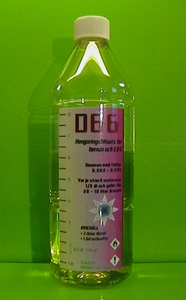 |
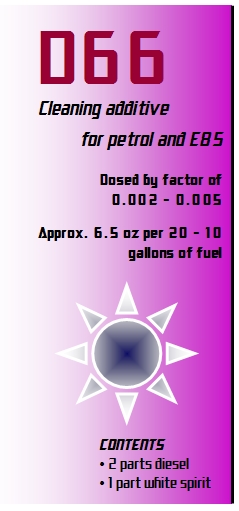 |
||
For both gasoline and E85. Power enhancing and cleans the fuel system. |
|||
Dose factor: 0.002 - 0.005 |
0.2 - 0.5 % |
||
2 parts diesel (city diesel/ACP) 1 part white spirit sum = 3 parts |
|||
Commentary |
|||
For glycol-based additives works D66 excellent but with no other additives makes D66 great use. Eg a petrol car that runs with D66 will soon begin to show
positive characteristics such as smoother running and more engine power. See the site about X66 for more
information. |
|||
Consumption gain: Not measured |
|||
Opening time reduction: 25-30 % |
|||
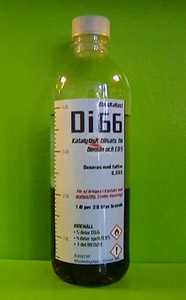 |
Shake before dosing! |
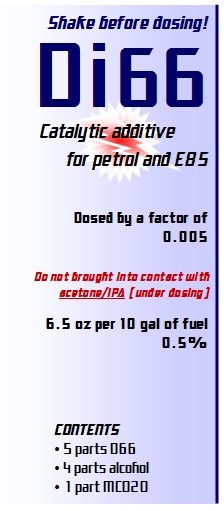 |
|
For both gasoline and E85. Cleans and load the engine with iron oxide. |
|||
Dose factor: 0.005 |
0.5 % |
||
Phase separated |
Clear liquid |
||
5 parts D66 1 part MCO20 4 parts 100% alcohol sum = 10 parts |
3 parts D66 1 part MCO20 6 parts 100% alcohol sum = 10 parts |
||
Commentary |
|||
Often referred to DiG when combined with blue glycol. Dosed always alone - never while an acetone additive is added! Di66 may not be combined with red
glycol additives such as G+. Di66 causes a red coating on all internal engine parts including spark plugs. Read the
site about MCO20 for more information. See picture
at layering after shaking. |
|||
Consumption gain: Not measured |
|||
The content of ferrous sulfate: 20 ppm |
Opening time reduction: 25-30 % |
||
 |
|||
For all fuels. Power enhancing and decrease consumption. |
|||
Dose factor: 0.01 in pure petrol |
1 % |
||
| For 10 gallons petrol dosed 15 oz For 10 gallons E85 dosed 3 oz |
|||
Commentary |
|||
IPA is temperature sensitive but can be added as a sub component. Bactericidal function in diesel. See the site about IPA for further information. |
|||
Consumption gain: Not measured |
|||
 |
|||
For both gasoline and E85. Power enhancing and decrease consumption. |
|||
Dose factor: 0.0018 in pure petrol |
0.18 % |
||
For 10 gallons E85 dosed 0.35 oz For 10 gallons E60 dosed 0.92 oz For 10 gallons E55 dosed 1.04 oz For 10 gallons E45 dosed 1.27 oz For 10 gallons E05 dosed 2.19 oz |
For 10 gallons pure petrol: 2.30 oz |
||
Commentary |
|||
Has major positive impact and added as a sub component. See the site about acetone for further information. |
|||
Consumption gain: 5-10 % (petrol fuels) |
|||
The effect of these additives is based on concentrated ethylene glycol and an acetone component. I first developed G+ but when the future is a bit uncertain for this additive, exists the need for an equally good additive but with other components. After many tests and some luck saw at the end DiG (Diesel Iron Glycol) to be a worthy substitute. DiG is slightly sharper than G+ but has some scary features, also may Di66 that is included in DiG not come into contact with undiluted additives as contain IPA, acetone or glycol - during the actual dosage. Although I run several hundred mil with DiG has nothing negative been seen but the risk is not completely zero, and the case probably glycol as an additive in the first place - it is a somewhat odd combination.
As is well known switches the composition of E85 with the seasons and that makes that G14a must be re-mixed when the transition from summer to winter ethanol takes place and vice versa. If UGA is in use one has to fill up the right parts of the fuels depending on the season. The rules on how to fill up is now written down in a crib that can be downloaded.
When G14a shall be converted to winter use, multiply 0.033 by the amount of G14a - gives amount (extra) acetone.
For the conversion to summer use, multiplied the amount of G14a (G9.33a) with 0.355 - gives amount (extra) glycol.
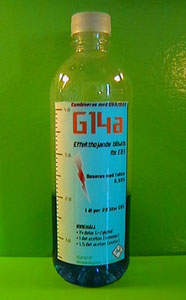 |
Shall be combined with D66/Di66 |
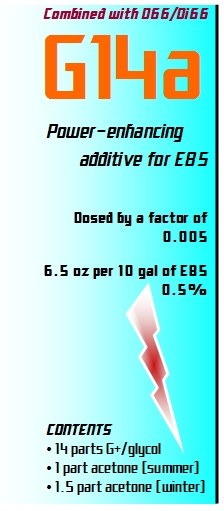 |
|
Only for E85. |
|||
Dose factor: 0.005 |
0.5 % |
||
Summer |
Winter |
||
14 parts G+ or blue glycol 1 part acetone sum = 15 parts |
14 parts G+ or blue glycol 1.5 part acetone sum = 15.5 parts |
||
Commentary |
|||
Also ordinary glycol (conc.) works - without hexamine or Di66 with blue glycol - but then is the improvement compared with G+ or DiG not so important anymore.
If this additive is based on DiG may it not be mixed with fuels with G+ additives or vice versa. Make it a habit to always dispense G14a after the fuel is
mixed with D66/Di66. Label for G14a with water. |
|||
Consumption gain: 0 % |
Opening time reduction G+ : 40 % |
||
Opening time reduction DiG: 50 % |
|||
Suppose you are a motorist who has a petrol car, but who lack the ability to experiment with technology, may simply not had time or wanted to put you into the topic of converting a petrol car for ethanol - for you should UGA fit nicely.
These additives makes that you at least can fill up half with E85 and half with E5, or at most 3 parts E85 and 1 part E5. Thus you avoid the risk of a hard starting car when it's cold outside, the water formation in the oil may not be serious consequences, one avoid puddles of water in the exhaust system - such as silencers, etc. and you become more environmentally friendly. Another tendency in a sloppy conversion is that the car will be somewhat difficult to start even when the engine is hot - that's because the engine temporarily get an overdose of fuel.
Not at least will it save you money, provided that the E85 is cheaper than gasoline (taking into account the higher consumption E85 causes). The fuel consumption increases, but it always does with E85 in the tank. UGA does not lower the fuel consumption, compared to E45-E60 without any additive.
It has been demonstrated that UGA-additive can be very opening time-reducing. Especially for the E45 and E60, giving UGA so little need of an extra opening time that the car can be run as if it were fuelled with regular gasoline.
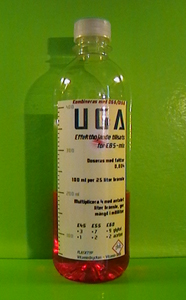 |
Shall be combined with D66/Di66 |
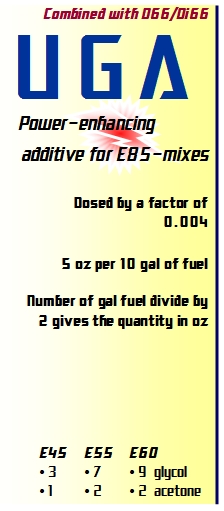 |
|
Unitary Glycol Acetone - for mixed fuels. |
|||
Dose factor: 0.004 |
0.4 % |
||
E45: 3 parts G+/DiG & 1 part acetone E55: 7 parts G+/DiG & 2 parts acetone E60: 9 parts G+/DiG & 2 parts acetone |
|||
Commentary |
|||
Here is the dosage
0.004 - a somewhat more difficult conversion factor than 0.005. Remember to distinguish between G+ and DiG-mixtures and never let Di66 brought into
contact with UGA!
Label for UGA with water. |
|||
Consumption gain: 0 % |
Opening time reduction E45: 75 % |
||
Opening time reduction E55: 0 % |
|||
Opening time reduction E60: 35 % |
|||
Other data:
ADDITIVE TYPE |
Conductivity µS/cm |
Opening time needs % |
E85 and G14a with G+ |
20 |
20.4 |
E85 and G14a with DiG |
12 |
17.6 |
E45 and UGA with G+ |
3 |
2.7 |
E45 and UGA with DiG |
3 |
2.7 |
E55 and UGA with G+ |
4 |
9.5 |
E55 and UGA with DiG |
5 |
9.5 |
E60 and UGA with G+ |
5 |
7.5 |
E60 and UGA with DiG |
6 |
7.5 |
Despite that, according to this chart
has a lower opening time needs at E55,
is the sum of the right-suited UGA-additive - not less than E45 and E60.
is the sum of the right-suited UGA-additive - not less than E45 and E60.
|
| |
|
| |








